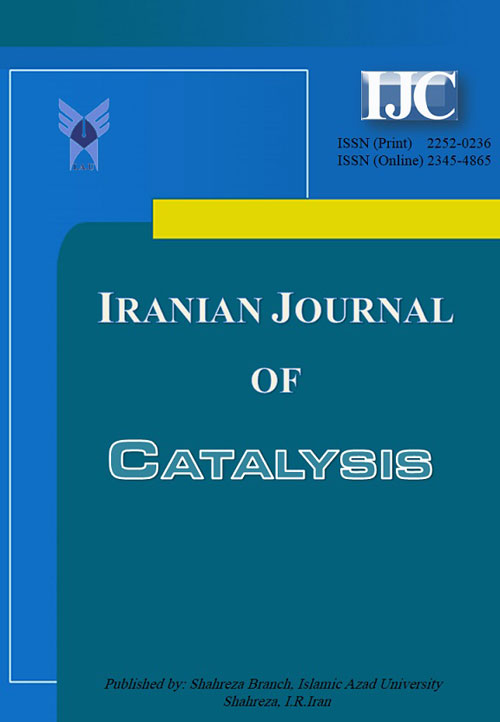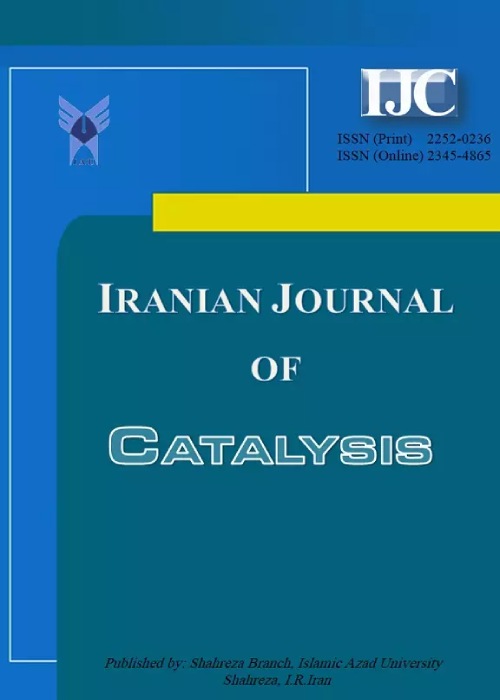فهرست مطالب

Iranian Journal of Catalysis
Volume:4 Issue: 4, Autumn 2014
- تاریخ انتشار: 1393/09/15
- تعداد عناوین: 12
-
-
Pages 219-226In this research work, we report a simple method called reflux condensation method for synthesizing Co3O4 nanoparticles using cheap chemicals such as, cobalt acetate (precursor salt), sodium monododecyl sulphate - SDS (surfactant) and N, N - Dimethylformamide - DMF (solvent). The prepared materials were heat treated at 200, 400, 600 and 800 oC for each 2 h to get phase pure product. The calcined nanoparticles were characterized by XRD, EDAX, FTIR Spectroscopy, Particle Size Analysis, SEM, UV-Vis Spectroscopy (UV) and Photo Luminescence (PL) Spectroscopy techniques. The XRD data confirmed the presence of crystallization of Co3O4 nanoparticles as face-centered cubic (Fd3m) structure. The appearance of Co-O stretching vibration mode and bridging vibration of O-Co-O bond in the samples found out by FTIR spectroscopy. The particlulate and microstructural studies revealed the occurrence of nanoparticles in the samples. The atomic percentages of Co and O were found to be 42% and 58% in the sample. This energy band gap for the sample is found to be 5.6 eV. Photocatalytic degradation characteristics of methyl orange and Rhodamine B using Co3O4 nanoparticles were studied and reported. Among the two dye samples studied, methyl orange was found to be degraded effectively (76%) with Co3O4 nanoparticles in presence of UV-light after two hours of irradiation.Keywords: Co3O4 nanoparticles, Reflux condensation method, Characterization, Photocatalytic studies
-
Pages 227-233Supported vanadia catalyst was successfully synthesized using wet impregnation of gamma-Alumina to study Propane Oxidative Dehydrogenation (POD). The prepared catalysts were characterized with XRD, BET, and TPR tests. In a broad temperature range (340 to 630°C), effects of vanadia loading (2.7, 5.4, and 9 wt%) and propane to oxygen ratio (3/1 to 1/3) were investigated on propane conversion as well as propene yield at atmospheric pressure. Results indicate that by increasing the vanadia content the activity of catalyst increases while selectivity to propene decreases monotonically. As the temperature increases from 340°C to 630°C, yield to propene shows ascending behavior in case of all catalyst samples. Yield to propene shows a climax with changing propane to oxygen ratio from 3/1 to 1/3. The yield increases with increase in oxygen partial pressure of feed until equimolar ratio of propane and oxygen, then it declines with further increase of oxygen partial pressure. Higher propene yields were observed at higher temperatures and equimolar feed ratio of propane and oxygen (C3/O2=1/1). A maximum propene yield of 17% was experienced on catalyst with 2.7 wt% vanadia at temperatures at 550°C.Keywords: Propane oxidative dehydrogenation, Vanadia loading, Gamma, Alumina, Temperature, Feed composition
-
Pages 235-239Silica ferric hydrogensulfate is an efficient heterogeneous catalyst for the cyclization of 2- aminochalcones to the corresponding 2,3-dihydroquinolin- 4(1H)-ones. This intramolecular aza Michael reaction was carried out in high yields using chalcones bearing of electron donating and electron withdrawing groups. The catalyst is reusable without significant decreases in its activity after four times recycling.The present study represents the application of silica supported ferric hydrogensulfate as catalyst for the aza-Michael cyclization of 2-aminochalcones to the corresponding 2-aryl-2,3-dihydroquinolone derivatives. Therefore, the simplicity of the procedure, the mildness of the reaction conditions, high yields, the ease of catalyst separation and its re-usability demonstrates the ability of this method.Keywords: Fe(HSO4)3, Heterogeneous, Dihydroquinolone, 4(1H), ones, Chalcones, aza, Michael
-
Pages 241-246Acetic acid has been applied as an efficient catalyst and a green solvent for the two–component condensation reaction consisting of benzaldehyde, 2-amino-benzamide. The advantages of this protocol was excellent yield, short reaction time, mild reaction conditions, higher availability, low costs, more environmentally friendly, lack of need for column chromatography and simple work-up procedure. In addition, based on the spectral data, the partial order with respect to each reactant was one. Furthermore, useful information regarding the mechanism of the reaction was obtained from studies of the effect of solvent, concentration and catalyst on the rate of the reaction. The results showed that the first step of the mechanism was a rate-determining step. In the studied temperature range, the second order rate constant (lnk1, lnk1/T) depended on reciprocal temperature was in good agreement with the Arrhenius and Eyring equations. These data provided the suitable plots for calculating the activation energy (Ea = 52.80 kJmol-1) and the related kinetic parameters (ΔG‡ = 63.74 kJmol-1, ΔS‡ = -54.22 Jmol-1 and ΔH‡ = 50.28 kJmol-1) of the reaction.Keywords: Catalyst, Kinetics, Mechanism, Green Solvent
-
Pages 247-251Maltose as an efficient, available, cheap and eco-friendly catalyst has been applied for the synthesis of 3,4,5-substituted furan-2(5H)one derivatives via a one-pot three-component reaction of arylamines, aromatic aldehydes and dialkyl acetylenedicarboxylates in water. This method has notable advantages in terms of simple workup, no need for column chromatography, short reaction time and high yields.Keywords: Maltose, 3, 4, 5, Substituted furan, (5H), Three, component reaction
-
Pages 253-2603-methyl-1-(4-sulfobuthyl)-1-H-imidazol-3ium hydrogen sulfate, as a dual acidic ionic liquid (DAIL), was found to be an efficient catalyst for the simple, rapid and green synthesis of substituted trisphenols from the condensation of different substituted phenols and 2,6-bis (methylol) phenols (BMP). DAIL catalyst efficiently promoted the reaction between phenols and BMPs with a variety of functionalities. Use of a non-corrosive and reusable catalyst, high yields of the products, short reaction times and solvent-free conditions are as worthwhile advantages of the present method.Keywords: 3, methyl, 1, (4, sulfobutyl), 1, H, imidazol, 3ium hydrogensulfate, Trisphenol, 2, 6, Bis(methylol)phenol, Dual acidic ionic liquid, Solvent, free
-
Pages 261-265A convenient, one-pot method for the synthesis of diazonium salt has been developed by the sequential diazotization of aromatic amines with NaNO2, polymer- supported periodic acid (PPIA) and 2-naphthole under solvent-free conditions at room temperature. By using this method, several types of aromatic amine, containing electron-withdrawing and electron-donating groups, were rapidly converted to the corresponding azo dyes in good to excellent yields. The ensuing aryl diazonium salts supported on polymer (aryl diazonium polymer), ArN2 +IO4 - were sufficiently stable to be kept at room temperature in the dry state. The use of mild reaction conditions and an inexpensive procedure are further advantages of this method.Keywords: Azo dye, Polymer, supported periodic acid, Diazotization, Solvent, free condition
-
Pages 267-272Molybdate sulfuric acid (MSA) has been prepared and used as catalyst for the Biginelli synthesis of some quinazolinones/thiones under solvent-free conditions. The catalyst loading is low and it shows recyclability. This method has advantages such as avoidance of the organic solvents, high yield of pure products, short reaction times and operational simplicity.Keywords: Biginelli, Molybdate sulfuric acid, Quinazolinones, thiones, Solvent, free
-
Pages 273-279[B(OH)3]0.78[B(OH)2(OSO3H)]0.22 or (BSA) was simply prepared by addition of chlorosulfonic acid to commercial boric acid at room temperature. This cheap and green solid acid was used as an efficient catalyst for synthesis of acylals from aldehydes under solvent-free conditions at room temperature.Keywords: [B(OH)3]0.78[B(OH)2(OSO3H)]0.22, Acylal, Protecting group, Aldehyde, BSA
-
Pages 281-288The ionic liquid Li(OHCH2CH2NH2)(CF3OAC) was found to efficiently catalyze the three-component reaction between different enols, aldehydes, and malononitrile, leading to rapid synthesis of 2-amino-4H-chromene derivatives in fairly high yields. The catalyst is easily prepared, highly stable, simple to handle and recycled for several times without significant loss of activity. The method is simple, starts from readily accessible commercial starting materials, and provides biologically interesting products in good yields and short reaction times. The desired ionic liquids, for aromatic aldehyde leads to get the products. Heating was very effective in increasing the efficiency of the product and in the presence of heat, the desired products were created in a shorter time.Keywords: Lithium, Ionic Liquid, Chromene derivatives, Reusable catalyst
-
Pages 289-294ZrP2O7 nanoparticles (NPs) as an efficient catalyst have been used for the preparation of 1،6-diamino-2- oxo-4-phenyl-1،2-dihydropyridine-3،5-dicarbonitrile derivatives via one-pot coupling of hyrazine hydrate، ethyl cyanoacetate، malononitrile and aromatic aldehydes under reflux conditions in ethanol. Using this method we obtained low reaction times، easy isolation of the targeted molecules، excellent yields.Keywords: ZrP2O7 nanoparticles, Multi, component, N, amino, 2, pyridones, One, pot, 1, 2, Dihydropyridines
-
Pages 295-303Michael addition of pyrimidine and purine nucleobases to substituted as well as unsubstituted α,β-unsaturated esters efficiently proceeds in the presence of catalytic amount of zinc oxide in ionic liquid 1-butyl-3-methylimidazolium bromide (ZnO/[bmim]Br) under microwave irradiation to afford carboacyclic nucleosides, as biologically important compounds, in good to excellent yields and in short reaction times.Keywords: Carboacyclic nucleoside, Michael addition, Zinc Oxide, Ionic Liquid, 1, Butyl, 3, methylimidazolium bromide ([bmim]Br), Microwave irradiation


